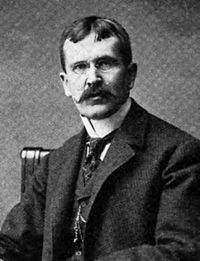Difference between revisions of "James Knox Taylor (1857-1929), Architect"
(Created page with "<div style="white-space:nowrap;font-size:125%">'''Washington, D.C.; Maine; New York; Florida'''</div style="white-space:nowrap;font-size:125%"> '''James Knox Taylor''' was b...") |
m |
||
| (2 intermediate revisions by the same user not shown) | |||
| Line 1: | Line 1: | ||
<div style="white-space:nowrap;font-size:125%">'''Washington, D.C.; Maine; New York; Florida'''</div style="white-space:nowrap;font-size:125%"> | <div style="white-space:nowrap;font-size:125%">'''Washington, D.C.; Maine; New York; Florida'''</div style="white-space:nowrap;font-size:125%"> | ||
| + | [[Image:James knox taylor portrait2019 1w.jpg|thumb|right|alt=James knox taylor portrait2019 1w.jpg|James Knox Taylor, ca. 1920.]] | ||
| − | '''James Knox Taylor''' was born on October 11, 1857 in Knoxville, Illinois.[[#References|[5]]] He worked in architecture in cities across the states, as well as in Washington, D.C. as the supervising architect for the U.S. Department of the Treasury.[[#References|[5]]] He also designed several post offices for Nebraska. Taylor died August 27, 1929.[[#References|[3]]] | + | |
| + | '''James Knox Taylor''' was born on October 11, 1857 in Knoxville, Illinois to Mary Young and Herman Knox.[[#References|[5]]] He worked in architecture in cities across the states, as well as in Washington, D.C. as the supervising architect for the U.S. Department of the Treasury.[[#References|[5]]] He also designed several post offices for Nebraska. He was married to Adele Chambers from Philadelphia. James Taylor died August 27, 1929.[[#References|[3]]] | ||
This page is a contribution to the publication, '''[[Place Makers of Nebraska: The Architects]]'''. See the [[Format and contents of Nebraska architect entries|format and contents]] page for more information on the compilation and page organization. | This page is a contribution to the publication, '''[[Place Makers of Nebraska: The Architects]]'''. See the [[Format and contents of Nebraska architect entries|format and contents]] page for more information on the compilation and page organization. | ||
| Line 10: | Line 12: | ||
==Educational & Professional Associations== | ==Educational & Professional Associations== | ||
| − | 1879: B.A. Massachusetts Institute of Technology, Cambridge, Massachusetts.[[#References|[5]]] | + | 1879: B.A., Massachusetts Institute of Technology, Cambridge, Massachusetts.[[#References|[5]]] |
1879-1882: architect, New York City.[[#References|[5]]] | 1879-1882: architect, New York City.[[#References|[5]]] | ||
| Line 25: | Line 27: | ||
==Buildings & Projects== | ==Buildings & Projects== | ||
| + | Drawing for U.S. Post Office (1900), Blair, Nebraska.[[#References|[6]]] | ||
| + | |||
U.S. Post Office & Courthouse (1904), 10th & P, Lincoln, Nebraska.[[#References|[4][2]]] | U.S. Post Office & Courthouse (1904), 10th & P, Lincoln, Nebraska.[[#References|[4][2]]] | ||
Revision as of 14:58, 6 February 2019
James Knox Taylor was born on October 11, 1857 in Knoxville, Illinois to Mary Young and Herman Knox.[5] He worked in architecture in cities across the states, as well as in Washington, D.C. as the supervising architect for the U.S. Department of the Treasury.[5] He also designed several post offices for Nebraska. He was married to Adele Chambers from Philadelphia. James Taylor died August 27, 1929.[3]
This page is a contribution to the publication, Place Makers of Nebraska: The Architects. See the format and contents page for more information on the compilation and page organization.
Contents
Compiled Nebraska Directory Listings
Educational & Professional Associations
1879: B.A., Massachusetts Institute of Technology, Cambridge, Massachusetts.[5]
1879-1882: architect, New York City.[5]
1882-1893: architect, St. Paul, Minnesota.[5]
1897-1912: Supervising architect, U.S. Department of the Treasure, Washington, D.C..[3][5]
1912-1914: faculty, Massachusetts Institute of Technology, Cambridge, Massachusetts.[5]
1914-1928: architect, Yonkers, New York and Philadelphia, Pennsylvania.[5]
1928: retired, Tampa, Florida.[5]
Buildings & Projects
Drawing for U.S. Post Office (1900), Blair, Nebraska.[6]
U.S. Post Office & Courthouse (1904), 10th & P, Lincoln, Nebraska.[4][2]
U.S. Post Office and Courthouse (1904), Norfolk, Nebraska.[1][2] National Register narrative
U.S. Post Office (ca. 1909), 626 Grant Ave., York, Nebraska. (YK11-002)
U.S. Post Office (1911), 2401 Central Ave., Kearney, Nebraska.[2] (BF05-169) National Register narrative
Notes
References
1. Oliver B. Pollak, Nebraska Courthouses: Contention, Compromise, and Community [Images of America Series] (Chicago: Arcadia Publishing, 2002), 121. [725.1.P771n]
2. Listed in the National Register of Historic Places.
3. AIA Historical Directory of American Architects: A Resource Guide to Finding Information About Past Architects, accessed August 3, 2010, http://communities.aia.org/sites/hdoaa/wiki/Wiki%20Pages/ahd1044342.aspx
4. Thomas Lee Kaspar (1951-____), Architect, comp. Inventory of architectural records in the archives of Davis Fenton Stange Darling, Architects, Lincoln, Nebraska. 1996. Nebraska State Historical Society, RG3748, Box 16.
5. "James Knox Taylor" FindaGrave.com Accessed February 6, 2019 via https://www.findagrave.com/memorial/155432840/james-knox-taylor
6. "James Knox Taylor" St. Croix Architecture (May 24, 2011). www.stcroixarchitecture.com
Other Sources
Entry in Henry F. Withey, A.I.A., and Elsie Rathburn Withey, Biographical Dictionary of American Architects (Deceased) (Los Angeles: New Age Publishing Company, 1956. Facsimile edition, Hennessey & Ingalls, Inc., 1970).
Page Citation
D. Murphy, “James Knox Taylor (1857-1929), Architect,” in David Murphy, Edward F. Zimmer, and Lynn Meyer, comps. Place Makers of Nebraska: The Architects. Lincoln: Nebraska State Historical Society, March 31, 2015. http://www.e-nebraskahistory.org/index.php?title=Place_Makers_of_Nebraska:_The_Architects Accessed, April 20, 2024.
Contact the Nebraska State Historic Preservation Office with questions or comments concerning this page, including any problems you may have with broken links (see, however, the Disclaimers link at the bottom of this page). Please provide the URL to this page with your inquiry.
